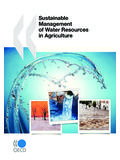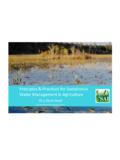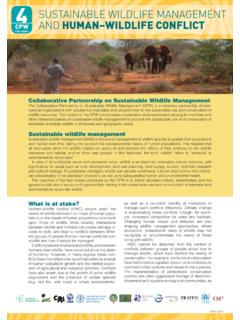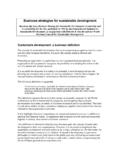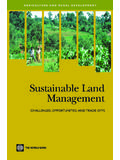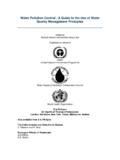Transcription of LAND AND WATER DIVISION WORKING PAPER 14
1 land AND WATER DIVISION . WORKING PAPER 14. land resource planning for sustainable land management Current and emerging needs in land resource planning for food security, sustainable livelihoods, integrated landscape management and restoration 14 land AND WATER DIVISION . WORKING PAPER . land resource planning for sustainable land management Current and emerging needs in land resource planning for food security, sustainable livelihoods, integrated landscape management and restoration A review of needs at various scales for tools and processes that can help countries and stakeholders meet emerging challenges, address increasing degradation of and competition for resources, support the sustainable use and restoration of land and WATER resources, and ensure resilient ecosystems By Feras Ziadat, Sally Bunning and Eddy De Pauw with contributions from Freddy Nachtergaele, Paolo Groppo, Riccardo Biancalani, Sergio ZelayaBonilla, Theodora Fetsi, Rosalud de la Rosa, Thomas Hammond, Stefan Schlingloff and Stephan Mantel (ISRIC).
2 FOOD AND AGRICULTURE ORGANIZATION OF THE UNITED NATIONS. Rome, 2017. The designations employed and the presentation of material in this information product do not imply the expression of any opinion whatsoever on the part of the Food and Agriculture Organization of the United Nations (FAO) concerning the legal or development status of any country, territory, city or area or of its authorities, or concerning the delimitation of its frontiers or boundaries. The mention of specific companies or products of manufacturers, whether or not these have been patented, does not imply that these have been endorsed or recommended by FAO in preference to others of a similar nature that are not mentioned. The views expressed in this information product are those of the author(s) and do not necessarily reflect the views or policies of FAO. ISBN 978-92-5-109896-7. FAO, 2017. FAO encourages the use, reproduction and dissemination of material in this information product.
3 Except where otherwise indicated, material may be copied, downloaded and printed for private study, research and teaching purposes, or for use in non-commercial products or services, provided that appropriate acknowledgement of FAO as the source and copyright holder is given and that FAO's endorsement of users' views, products or services is not implied in any way. All requests for translation and adaptation rights, and for resale and other commercial use rights should be made via or addressed to FAO information products are available on the FAO website ( ). and can be purchased through Cover photos: FAO/Simon Maina iii Contents Acknowledgements v Glossary vi Acronyms & abbreviations viii Executive summary ix Background 1. Current and emerging needs 3. land resource planning and integrated land resource management 9. land resource planning and sustainable land management 12. Features of land resource planning tools 15. Stocktake of needs and emerging issues for updating 18.
4 land resource planning tools and approaches Survey on participatory land resource planning tools 20. Characteristics of survey participants and their organizations 21. Characteristics and perceptions of the tools 23. and data used in land resource planning Eliciting ideas for further tool development 26. Regional accents 27. The land Resources Planning Toolbox 29. References 34. Annex 1. Survey questions 39. Annex 2. Tools in the land Resources Planning Toolbox 49. v Acknowledgements We would like to acknowledge the contribution of Alastair Sarre in editing the WORKING PAPER and James Morgan for the layout and final production. vi Glossary Biodiversity The 2015 FAO Global Forest Resources Assessment and the Convention on Biological Diversity uses the following definition: "The variability among living organisms from all sources including, inter alia, terrestrial, marine and other aquatic ecosystems and the ecological complexes of which they are part; this includes diversity within species, among species and of ecosystems.
5 ". Ecosystem services The benefits people obtain from ecosystems. These include provisioning services such as food and WATER ; regulating services such as flood and disease control; cultural services such as spiritual, recreational and cultural benefits; and supporting services such as nutrient cycling that maintain the conditions for life on Earth (Millennium Ecosystem Assessment, 2005). Integrated landscape management Ensures that by managing the underpinning natural resource base and ecosystem services through a coordinated process across sectors and stakeholders, the range of societal needs can be met in the short and long terms. Diverse landscape management approaches have been developed from different entry points but aimed at realizing multiple outcomes simultaneously. Commonalities include: generating an agreed vision among stakeholders of long-term and wide-scale landscape goals;. adopting a mosaic of practices that achieve multiple objectives; devising strategies to manage spatial interactions across different land uses and users; establishing institutions for stakeholder dialogue, negotiation and action; and shaping markets and policies to support desired outcomes.
6 These process, technical, socioeconomic, market and policy dimensions are mutually reinforcing (Landscapes for People, Food and Nature, 2015). land A delineable area of the Earth's terrestrial surface, encompassing all attributes of the biosphere immediately above or below this surface, including those of the near-surface climate, the soil and terrain forms, the surface hydrology (including shallow lakes, rivers, marshes and swamps), the near-surface sedimentary layers and associated groundwater reserve, the plant and animal populations, the human settlement pattern and the physical results of past and present human activity, such as terracing, vii WATER storage and drainage structures, infrastructure and buildings (United Nations, 1995). Landscape An area of land containing a mosaic of ecosystems, including human- dominated ecosystems. The term cultural landscape is often used when referring to landscapes containing significant human populations.
7 (Millennium Ecosystem Assessment, 2003). land use planning this is the systematic assessment of land potential and alternatives for optimal land uses and improved economic and social conditions through participatory processes that are multisectoral, multistakeholder and scale- dependent. The purpose of land -use planning is to support decision- makers and land users in selecting and putting into practice those land uses that will best meet the needs of people while safeguarding natural resources and ecosystem services for current and future generations. Tools and methods for land -use planning at appropriate scales should encourage and assist the diverse and often competing users of land resources in selecting land -use and management options that increase their productivity, support sustainable agriculture and food systems, promote governance over land and WATER resources and meet the needs of society (adapted from FAO, 1993).
8 land resource planning This is similar to land -use planning but, in this PAPER , the term is used in a broader sense. Thus, land resource planning encompasses land evaluation and land -use planning and addresses the biophysical, socio-economic and negotiatory domains. viii Acronyms &. abbreviations CBL land and WATER DIVISION of FAO. FAO Food and Agriculture Organization of the United Nations GIS Geographic information system INDC Intended nationally determined contribution ISRIC International Soil Reference and Information Centre LADA land Degradation Assessment in Dryland Areas LRP land resource planning NDC Nationally determined contribution SDG sustainable Development Goal SLM sustainable land management WOCAT World Overview of Conservation Approaches and Technologies ix Executive summary This WORKING PAPER provides an overview of the historic development and status of implementation of land evaluation and land -use planning concepts and tools for land resource and landscape management , and it proposes recommendations for future actions.
9 The increasing and juxtaposed challenges of population growth, demands on limited resources by diverse actors, land degradation, biodiversity loss and climate change require the rational use of resources to sustain and enhance productivity and maintain resilient ecosystems. land -use planning and, more broadly, land resource planning (LRP), are tools for achieving the sustainable and efficient use of resources, taking into account biophysical and socio- economic dimensions. The availability of suitable tools and information to support and satisfy the needs of decision-makers at different scales, across sectors and among stakeholders is limited, however. The needs of decision-makers to address the challenges and drivers of change and promote effective and sustainable responses calls for an updated set of tools and approaches for participatory LRP. Such a set of tools should take into account biophysical, economic, socio-cultural and governance dimensions, and it should promote integrated landscape management as a means to satisfy the needs of multiple stakeholders and implement diverse national strategies and commitments.
10 It is proposed that a consultation process involving a wide range of stakeholders operating at different scales be undertaken to bring together lessons and experiences in tools and approaches for LRP and to identify the main gaps and opportunities. This consultation process should lead to the formulation, with partners, of a strategy for the development, testing and validation of updated LRP tools in pilot countries with stakeholders and decision-makers, from the scale of local landscapes to the subnational, national and transboundary scales. To initiate such a process, the land and WATER DIVISION of FAO conducted a survey among stakeholders operating at different scales and in different sectors and regions to compile lessons and experiences from users of LRP. tools and approaches and to identify challenges in the use of such tools, the need for and gaps in LRP tools, and possible future actions. The survey provided useful perspectives among professionals on the gaps and bottlenecks in LRP tools and opportunities for future development.










